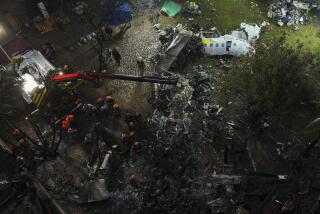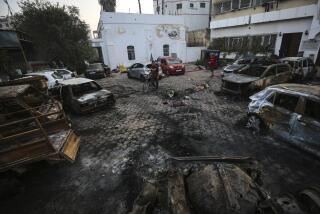Investigators say Air France jet made hard landing, broke up on hitting water
- Share via
PARIS — Air France Flight 447, which crashed into the Atlantic Ocean, killing all 228 people aboard, probably made a hard belly landing and broke up on impact, French investigators said Thursday, citing preliminary evidence.
None of the life jackets found by salvage teams were inflated, meaning passengers were not able to prepare for a water landing, said lead investigator Alain Bouillard. He said investigators could not determine whether the passengers were conscious at the time of the crash.
A report by investigators says crumpled walls, a distorted toilet stall and food trolleys that appeared to be compressed from the bottom were among indications that the plane hit the water hard at a relatively shallow angle. But without larger pieces of wreckage and the flight recorders, Bouillard said, his team is a long way from determining the cause of the crash.
The Airbus A330 jetliner left Rio de Janeiro on May 31 for Paris and crashed about 930 miles off Brazil’s coast.
Bouillard said airspeed sensors known as pitot tubes were an “element, but not the cause” of the accident. Investigators said previously that the sensors failed, but Bouillard said no direct link had been confirmed between that event and the faulty speed readings that set off other failure notices and threw the plane off autopilot.
The French investigators also lamented that it apparently took about six hours for controllers along the flight path to sound a warning that the aircraft might be in danger.
In the report, investigators included a transcript of messages among international air controllers unable to contact Flight 447. Controllers in Dakar, Senegal, made repeated calls to colleagues along the route, as well as another Air France flight, which contacted airline officials.
A distress signal was finally sent from Madrid and Brest, France, because the plane hadn’t arrived there.
It took several days to find the first remnants of the crash, one reason investigators are facing the “worst possible combination of circumstances” for conducting a search, said Philip Swan, an advisor to the French investigation.
Floating debris has been found, but no sunken, larger pieces of the aircraft. Stormy weather helped scatter debris from the crash point.
In the meantime, the flight recorders have a limited time remaining to send out signals.
More to Read
Sign up for Essential California
The most important California stories and recommendations in your inbox every morning.
You may occasionally receive promotional content from the Los Angeles Times.













